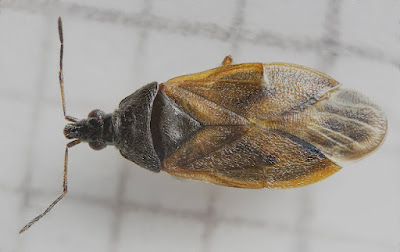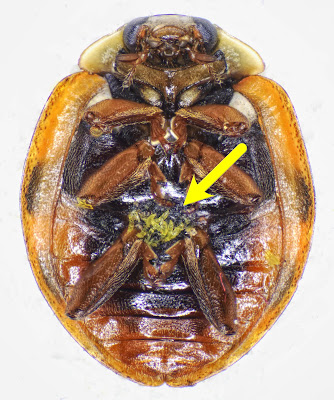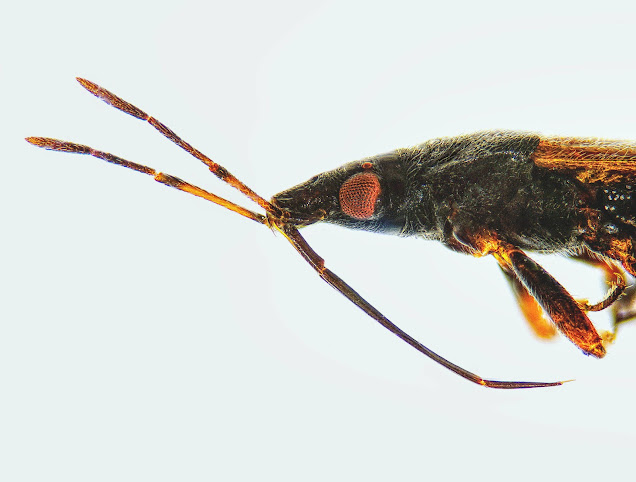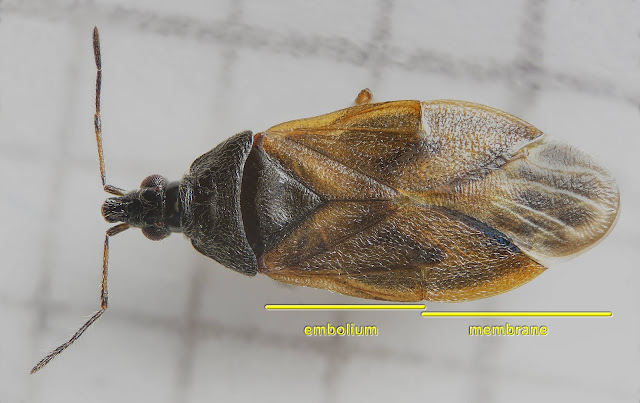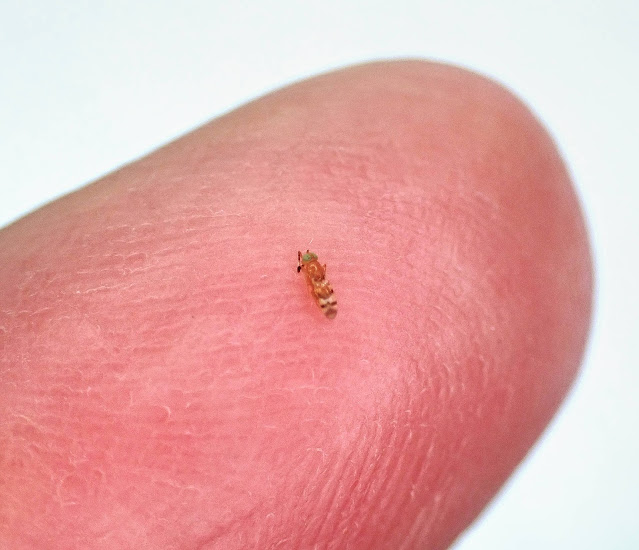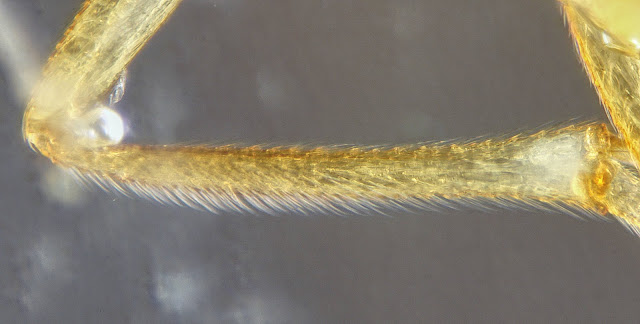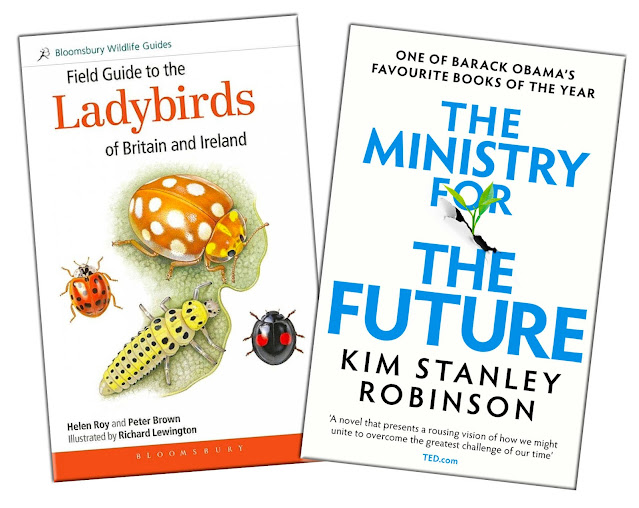If you'd like to receive free montly updates via email, please let me know.
Although February's weather continued to be challenging, the month turned out to be unexpectedly productive, including the first record of a new genus for VC55.
Beetles and Barnacles
I spent a lot of February furtling around in Ivy, so for a change I decided to go and bother some local conifers. This turned out to be surprisingly productive, turning up lots of Ladybirds and Bugs, but also a few Beetles. I managed to identify the quite distinctive Cartodere bifasciata without too much trouble, but this 2mm beetle was another story. The Facebook Beetles of Britain and Ireland group was able to confirm that it is Cryptophagus, but Clive Washington warned me that there was trouble ahead. After looking at the key, I decided to give up fairly quickly. It is comforting to know that Darwin felt challenged in much the same way about Barnacles as I do about Beetles (albeit he was far more competent). This has been well and entertainingly documented by Rebecca Stott (Darwin and the Barnacle. (2004) New York: Farber & Farber) - recommended reading. Good to know that Darwin had similar problems with microscope dissections (specimens pinged across the room) as I do (although bugs not barnacles in my case).
My Journal, February 2024
01.ii.2024
Back to the churchyard for a few more Microterys seryon, then spent a while taking photos of the hairs on the leg of a 2mm wasp. Entomology!
02.ii.2024
Hedge pruning on a warm and sunny afternoon. The Pulmonaria is out and the Hairy-footed Flower Bees can't be far behind. I always think of Maggie Frankum when the Pulmonaria flowers.
03.ii.2024
A short trip to Billesdon on a warm morning. Sadly the tidy brigade blitzkrieg has reduced the wildlife value of the site. Sifted a range of things from moss.
05.ii.2024
Finished the samples from Billesdon. A surprising range of arthropods hunkered down in the moss.
06.ii.2024
A brief, very breezy and quite unproductive visit to Lucas's Marsh before the rain.
07.ii.2024
Working on some samples that were sent to me when the thing I hate happened. An interesting bug I didn't recognise pinged off the stage and dematerialized. Why does it only happen with the good ones?
09.ii.2024
Unremitting rain. In the ongoing battle of water table versus lawn water table comes out on top. The ephemeral stream that runs through the posh houses is up for the first time this winter.
12.ii.2024
Biodiversity Net Gain is here. I wish I could be positive about this but I'm not. Possible gains 30 years in the future but no hope of it being monitored or enforced. We can't even look after existing SSSIs. On the plus side, a territorial Wren singing in the garden. Sorry spiders!
13.ii.2024
Out early(ish) this morning for some local Ivy-bothering. Didn't quite beat the rain but was surrounded by enough birdsong to make it feel like spring.
15.ii.2024
15C and it feels like spring. Lots of birdsong and a productive session beating conifers. Brimstone Butterflies on the wing all over the County. Some local conifers proved to be very interesting, and I found a single Acompocoris alpinus - the first VC55 record for this genus. Very pleased!
16.ii.2024
Buoyed with enthusiasm by yesterday's weather I ran the moth trap for the first time this year. Sadly, it was chillier (6C) and windier than I had hoped and the moths stayed away. A few years ago I would have expected a few moths at this time of year, but moths in my suburban garden have massively declined. The Met office published data showing that the average UK winter has become around 1C warmer and 15% wetter over the past century. Six of the 10 warmest winters on record were in the 21st century, and four of these also rank in the top 10 wettest years on record.
19.ii.2024
A short trip to the local park to beat conifers was very successful. I hadn't remembered there were as many Scots Pines there. These proved to be very productive, yielding 10 species of ladybird: 7 Spot Ladybird, 10-spot Ladybird, 18 Spot Ladybird, Cream-streaked Ladybird, Epaulet Ladybird, Eyed Ladybird, Harlequin Ladybird, Larch Ladybird, Pine Ladybird, Scymnus suturalis. Unexpectedly, this is turning into the Year of the Ladybird. In addition to this I also found another female Acompocoris alpinus. A very good outing.
21.ii.2024
Worked on springtails I was given from pitfall traps. Was reminded what a taxonomic mess the genus Isotomurus is!
22.ii.2024
Another miserable day so more pickled pitfall springtails. Coal Tits are competing with the Great Tits for one of the garden nest boxes.
23.ii.2024
Working through some 2023 Anthocoridae specimens I was given. They're a challenge but I do feel confident with this group now.
24.ii.2024
Spent the morning messing about with a Harlequin Ladybird infected with Hesperomyces harmoniae I found in the bedroom. Very enjoyable! Also agreed to do my first talk on ladybirds and lead a ladybird walk. Ladybirds ladybirds ladybirds!
In the afternoon I took advantage of the sunshine for a quick trip to the Botanical Garden where I found some nice leafhoppers overwintering on conifers, Metidiocerus rutilans and Balclutha punctata.
26.ii.2024
Visited a private Charnwood rewilding project to do some sampling. Nice day but cold. A good range of invertebrates via the vacuum sampler.
27.ii.2024
Charnwood invertebrate sorting. Cold, but the Marsh Marigolds in our bog are out.
28.ii.2024
Meeting at County Hall discussing Local Nature Recovery Strategy. In the afternoon I huddled over a nice warm microscope looking at spiders from Monday's site visit.
29.ii.2024
Happy Leap Day! I celebrated by staying out of the rain. February seems determined to finish as the wettest on record (close now). Sweet Violets are out on the remnant verge by the posh houses.


